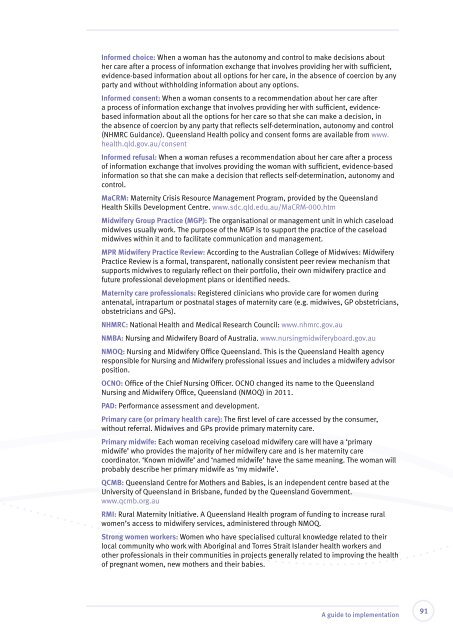Delivering continuity of midwifery care to Queensland women
Delivering continuity of midwifery care to Queensland women
Delivering continuity of midwifery care to Queensland women
You also want an ePaper? Increase the reach of your titles
YUMPU automatically turns print PDFs into web optimized ePapers that Google loves.
Informed choice: When a woman has the au<strong>to</strong>nomy and control <strong>to</strong> make decisions about<br />
her <strong>care</strong> after a process <strong>of</strong> information exchange that involves providing her with sufficient,<br />
evidence-based information about all options for her <strong>care</strong>, in the absence <strong>of</strong> coercion by any<br />
party and without withholding information about any options.<br />
Informed consent: When a woman consents <strong>to</strong> a recommendation about her <strong>care</strong> after<br />
a process <strong>of</strong> information exchange that involves providing her with sufficient, evidencebased<br />
information about all the options for her <strong>care</strong> so that she can make a decision, in<br />
the absence <strong>of</strong> coercion by any party that reflects self-determination, au<strong>to</strong>nomy and control<br />
(NHMRC Guidance). <strong>Queensland</strong> Health policy and consent forms are available from www.<br />
health.qld.gov.au/consent<br />
Informed refusal: When a woman refuses a recommendation about her <strong>care</strong> after a process<br />
<strong>of</strong> information exchange that involves providing the woman with sufficient, evidence-based<br />
information so that she can make a decision that reflects self-determination, au<strong>to</strong>nomy and<br />
control.<br />
MaCRM: Maternity Crisis Resource Management Program, provided by the <strong>Queensland</strong><br />
Health Skills Development Centre. www.sdc.qld.edu.au/MaCRM-000.htm<br />
Midwifery Group Practice (MGP): The organisational or management unit in which caseload<br />
midwives usually work. The purpose <strong>of</strong> the MGP is <strong>to</strong> support the practice <strong>of</strong> the caseload<br />
midwives within it and <strong>to</strong> facilitate communication and management.<br />
MPR Midwifery Practice Review: According <strong>to</strong> the Australian College <strong>of</strong> Midwives: Midwifery<br />
Practice Review is a formal, transparent, nationally consistent peer review mechanism that<br />
supports midwives <strong>to</strong> regularly reflect on their portfolio, their own <strong>midwifery</strong> practice and<br />
future pr<strong>of</strong>essional development plans or identified needs.<br />
Maternity <strong>care</strong> pr<strong>of</strong>essionals: Registered clinicians who provide <strong>care</strong> for <strong>women</strong> during<br />
antenatal, intrapartum or postnatal stages <strong>of</strong> maternity <strong>care</strong> (e.g. midwives, GP obstetricians,<br />
obstetricians and GPs).<br />
NHMRC: National Health and Medical Research Council: www.nhmrc.gov.au<br />
NMBA: Nursing and Midwifery Board <strong>of</strong> Australia. www.nursing<strong>midwifery</strong>board.gov.au<br />
NMOQ: Nursing and Midwifery Office <strong>Queensland</strong>. This is the <strong>Queensland</strong> Health agency<br />
responsible for Nursing and Midwifery pr<strong>of</strong>essional issues and includes a <strong>midwifery</strong> advisor<br />
position.<br />
OCNO: Office <strong>of</strong> the Chief Nursing Officer. OCNO changed its name <strong>to</strong> the <strong>Queensland</strong><br />
Nursing and Midwifery Office, <strong>Queensland</strong> (NMOQ) in 2011.<br />
PAD: Performance assessment and development.<br />
Primary <strong>care</strong> (or primary health <strong>care</strong>): The first level <strong>of</strong> <strong>care</strong> accessed by the consumer,<br />
without referral. Midwives and GPs provide primary maternity <strong>care</strong>.<br />
Primary midwife: Each woman receiving caseload <strong>midwifery</strong> <strong>care</strong> will have a ‘primary<br />
midwife’ who provides the majority <strong>of</strong> her <strong>midwifery</strong> <strong>care</strong> and is her maternity <strong>care</strong><br />
coordina<strong>to</strong>r. ‘Known midwife’ and ‘named midwife’ have the same meaning. The woman will<br />
probably describe her primary midwife as ‘my midwife’.<br />
QCMB: <strong>Queensland</strong> Centre for Mothers and Babies, is an independent centre based at the<br />
University <strong>of</strong> <strong>Queensland</strong> in Brisbane, funded by the <strong>Queensland</strong> Government.<br />
www.qcmb.org.au<br />
RMI: Rural Maternity Initiative. A <strong>Queensland</strong> Health program <strong>of</strong> funding <strong>to</strong> increase rural<br />
<strong>women</strong>’s access <strong>to</strong> <strong>midwifery</strong> services, administered through NMOQ.<br />
Strong <strong>women</strong> workers: Women who have specialised cultural knowledge related <strong>to</strong> their<br />
local community who work with Aboriginal and Torres Strait Islander health workers and<br />
other pr<strong>of</strong>essionals in their communities in projects generally related <strong>to</strong> improving the health<br />
<strong>of</strong> pregnant <strong>women</strong>, new mothers and their babies.<br />
A guide <strong>to</strong> implementation<br />
91
















